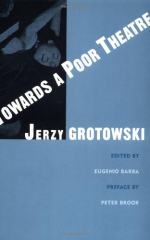
|
| Name: _________________________ | Period: ___________________ |
This test consists of 15 multiple choice questions and 5 short answer questions.
Multiple Choice Questions
1. What type of respiration is the most effective for the actor?
(a) Lower respiration.
(b) Deep respiration.
(c) Upper respiration.
(d) Total respiration.
2. Part IV of "Actor's Training (1959 - 1962)" are what kind of exercises?
(a) Animal.
(b) Voice.
(c) Flight.
(d) Upside down.
3. What does Grotowski claim that a great Polish actor before the war referred to exhibitionism as?
(a) Voyeurism.
(b) Narcissism.
(c) Publicotropism.
(d) Egotism.
4. Who built his methods on the spontaneity of daily life, according to Grotowski in "The Actor's Technique"?
(a) Brecht.
(b) Stanislavski.
(c) Artaud.
(d) Meyerhold.
5. It is the task of _____ to amplify the carrying power of sound emitted in the actor.
(a) The tongue.
(b) Resonators.
(c) Vocal chords.
(d) The lungs.
6. Grotowski states in "The Actor's Technique" that when he first begins work with an actor his first question is "Does this actor have any _____ difficulties?"
(a) Intellectual.
(b) Physical.
(c) Breathing.
(d) Emotional.
7. Grotowski states in "American Encounter" that an _____ confession is no confession at all."
(a) Untrue.
(b) Irresolute.
(c) Inarticulate.
(d) Irredeemable.
8. Part V of "Actor's Training (1959 - 1962)" are "Leaps and _____."
(a) Falls.
(b) Gestures.
(c) Dances.
(d) Somersaults.
9. In "Actor's Training (1959 - 1962)", Grotowski notes that "The exercise serves the _____."
(a) Research.
(b) Point.
(c) Creativity.
(d) Mind.
10. The notes of "Actor's Training (1966)" were taken by _____.
(a) Robert Fischer.
(b) Franz Marijnen.
(c) Dale Landstorm.
(d) Sanford Meisner.
11. How many types of respiration are there, as noted by Grotowski in "Actor's Training (1959 - 1962)"?
(a) Three.
(b) Five.
(c) Four.
(d) Two.
12. Grotowski points out in all of his lessons in "Actor's Training (1966)" that _____ must be excluded in the exercises.
(a) Thought.
(b) Feeling.
(c) Connection.
(d) Gravity.
13. What does Grotowski approach second in "Actor's Training (1966)"?
(a) Floor work.
(b) Animal exercises.
(c) Tiger.
(d) Stimulation of the Voice.
14. The problem that Grotowski encountered with Yoga for achieving concentration in the actor was that the concentration was _____.
(a) Impulsive.
(b) Internal.
(c) Quiet.
(d) External.
15. The actor should take special care to open the _____ when speaking and breathing.
(a) Mouth.
(b) Pharynx.
(c) Lungs.
(d) Larynx.
Short Answer Questions
1. In "Dr. Faustus", the spectators are _____.
2. Who does Grotowski say devised many good exercises, some with masks in "The Actor's Technique"?
3. Grotowski states in "American Encounter" that he never used the following word although it was at the heart of what he said.
4. The Skara Drama School is located in _____.
5. Section B of "Actor's Training (1959 - 1962)" are based upon the work of _____.
|
This section contains 373 words (approx. 2 pages at 300 words per page) |

|




